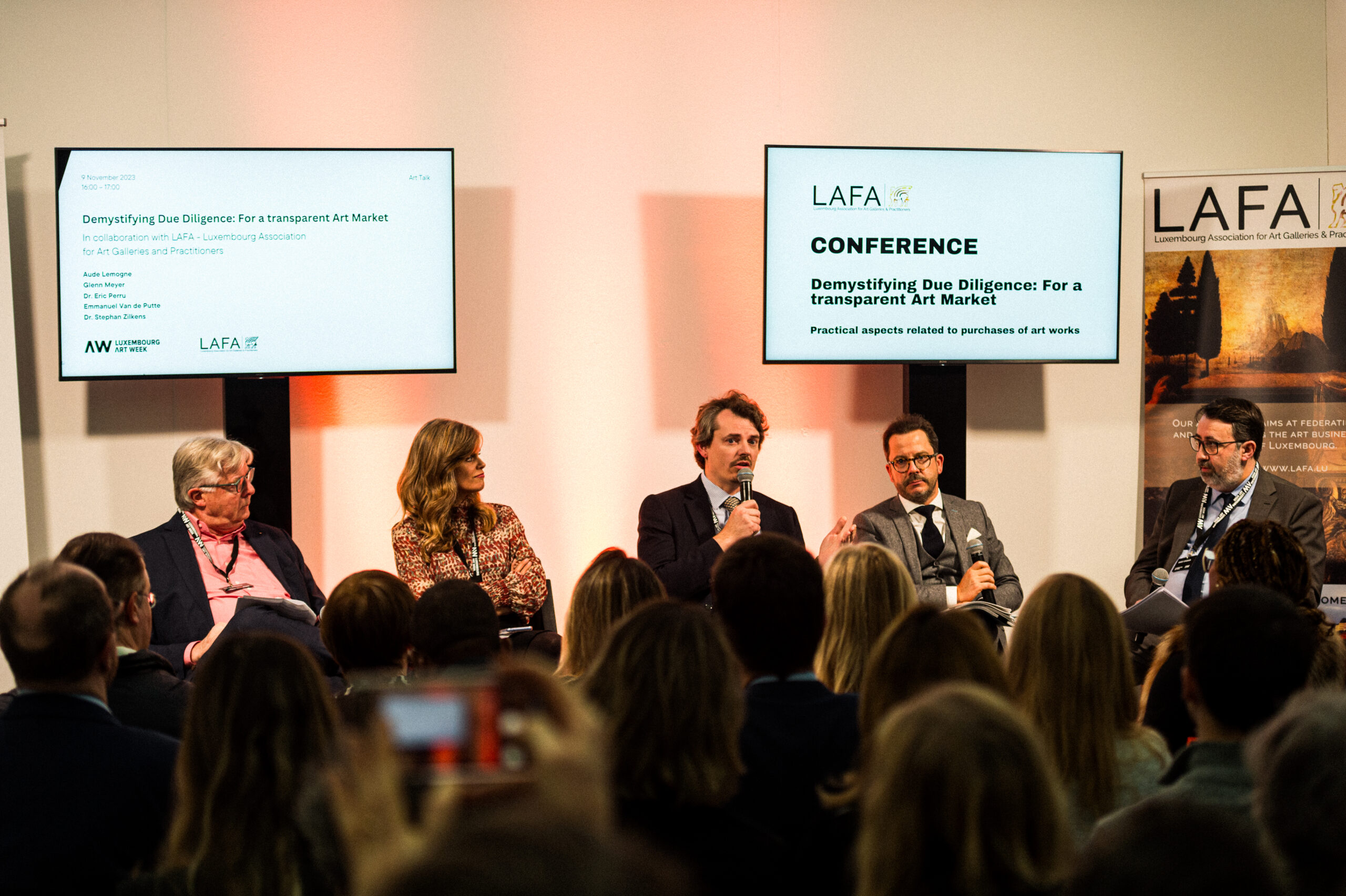In today’s art market, collectors, investors, family offices, and private banks have become increasingly cautious when involved in art transactions. Due diligence has become an essential component, ensuring the legitimacy and safety of these high-value exchanges. This article synthesizes insights from a recent conference aimed at demystifying the art collecting journey, highlighting practical tips from a panel of seasoned art market professionals, held on the occasion of the 2023 edition of Luxembourg Art Week in the art fair premices.
The Importance of Due Diligence in Art Transactions
Due diligence is crucial in the art market, providing a comprehensive investigation into the parties involved, the artwork itself, and the transaction process. This rigorous examination protects art businesses and collectors, helping them manage and mitigate risks associated with art transactions. The following key areas of due diligence were discussed:
Client Due Diligence
Client due diligence involves a thorough investigation of the seller’s credentials, the intermediaries involved, and their authority to act. This includes:
- Seller’s Credentials: Verifying the authenticity and credibility of the seller.
- Intermediaries: Ensuring that intermediaries have the legal authority to represent the seller and act in the transaction.
- Sanctions and Red Flags: Conducting checks to identify any sanctions or red flags associated with the parties involved.
As Aude Lemogne, Director at Link Management and member of the Board of Directors of AXA Wealth Europe, stated, “Understanding who you are dealing with is the first step in mitigating risks. Thoroughly vetting the seller and intermediaries can prevent potential fraud and legal issues.”
Artwork Due Diligence
Investigating the artwork itself is another critical aspect, encompassing:
- Identification: Confirming the identity and details of the artwork.
- Ownership/Title: Verifying the legal ownership and title of the artwork.
- Location and Movement: Tracking the artwork’s location and its recent movements.
- Forensic Analysis: Conducting thorough provenance research, assessing the artwork’s condition and authenticity.
- Valuation: Determining the accurate market value of the artwork.
Emmanuel Van de Putte, Senior Director and Managing Director at Sotheby’s Brussels and Luxembourg, emphasized, “Proper provenance research and forensic analysis are vital. They ensure that the artwork is authentic and legally acquired, which is crucial for maintaining the integrity of the art market.”
Transaction Due Diligence
This involves scrutinizing the transaction’s purpose, form, and associated documentation:
- Purpose and Form of Transaction: Understanding the intention behind the transaction and its legal structure.
- Source of Funds: Verifying the legitimacy of the funds used in the transaction.
- Litigation and Regulatory Risks: Assessing potential litigation risks and ensuring compliance with regulatory requirements, including import and export restrictions and Anti-Money Laundering (AML) laws.
Glenn Meyer, Partner in the Banking & Financial Services practice at Arendt & Medernach, noted, “Ensuring that the transaction is transparent and compliant with all legal requirements is essential. This includes verifying the source of funds and understanding the regulatory landscape to avoid legal pitfalls.”
Dr. Stephan Zilkens, Managing Partner at Zilkens Fine Art Insurance Broker GmbH, also pointed out, “Insurance plays a crucial role in managing the financial risks associated with art transactions. It provides a safety net that can cover unforeseen circumstances, including damage during transport or legal disputes.”
Expert Insights and Best Practices
The conference, moderated by Dr. Eric Perru, Partner at Pinsent Masons Luxembourg and Vice-President of LAFA, featured notable speakers who shared their expertise on mitigating risks in art transactions:
- Aude Lemogne: Emphasized the importance of thorough client and artwork due diligence.
- Glenn Meyer: Highlighted the necessity of rigorous transaction due diligence, focusing on regulatory compliance.
- Emmanuel Van de Putte: Discussed the significance of forensic analysis and accurate valuation.
- Dr. Stefan Zilkens: addressed the role of insurance in managing risks and the logistics of handling high-value artworks.
Conclusion
The art market demands a high level of scrutiny and diligence to ensure safe and legitimate transactions. By incorporating comprehensive due diligence practices, collectors, investors, and art professionals can effectively manage and mitigate the risks associated with buying and selling artworks. This conference provided valuable insights and practical tips, reinforcing the necessity of due diligence in safeguarding the integrity of art transactions. As Dr. Eric Perru summarized, “A diligent and informed approach is the best defense against the complexities and risks inherent in the art market.”
For those interested in a deeper dive into these expert discussions and practical tips on mitigating risks in art transactions, you can watch the full conference here.

